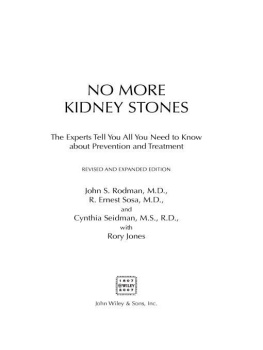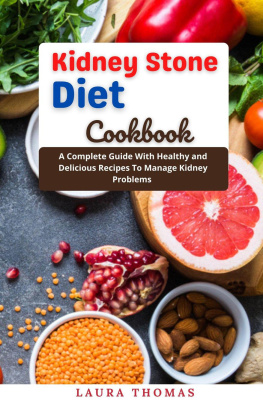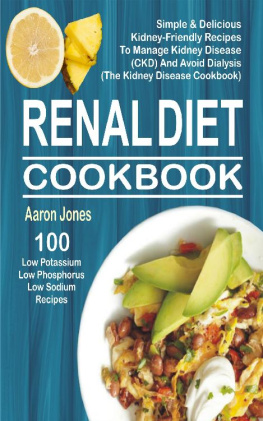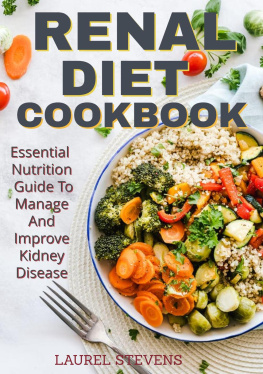Table of Contents
Copyright 2007 by John Rodman, M.D., R. Ernest Sosa, M.D., Cynthia Seidman, M.S., R.D., and Rory Jones. All rights reserved.
Published by John Wiley & Sons, Inc., Hoboken, New Jersey
Published simultaneously in Canada
Wiley Bicentennial Logo: Richard J. Pacifico
No part of this publication may be reproduced, stored in a retrieval system, or transmitted in any form or by any means, electronic, mechanical, photocopying, recording, scanning, or otherwise, except as permitted under Section 107 or 108 of the 1976 United States Copyright Act, without either the prior written permission of the Publisher, or authorization through payment of the appropriate per-copy fee to the Copyright Clearance Center, 222 Rosewood Drive, Danvers, MA 01923, (978) 750-8400, fax (978) 646-8600, or on the web at www.copyright.com. Requests to the Publisher for permission should be addressed to the Permissions Department, John Wiley & Sons, Inc., 111 River Street, Hoboken, NJ 07030, (201) 748-6011, fax (201) 748-6008, or online at http://www.wiley.com/go/permissions.
Medical disclaimer: The information contained in this book is not intended to serve as a replacement for professional medical advice. Any use of the information in this book is at the readers discretion. The author and the publisher specifically disclaim any and all liability arising directly or indirectly from the use or application of any information contained in this book. A health care professional should be consulted regarding your specific situation.
For general information about our other products and services, please contact our Customer Care Department within the United States at (800) 762-2974, outside the United States at (317) 572-3993 or fax (317) 572-4002.
Wiley also publishes its books in a variety of electronic formats. Some content that appears in print may not be available in electronic books. For more information about Wiley products, visit our web site at www.wiley.com.
Library of Congress Cataloging-in-Publication Data:
No more kidney stones / John S. Rodman... [et al.].Rev. ed.
p. cm.
Includes bibliographical references (p. ).
ISBN 978-0-471-73929-6 (pbk.)
1. KidneysCalculiPrevention. I. Rodman, John S., 1946-
RC916.R63 2006
616.62205dc22
2006042148
PREFACE
When I started practicing nephrology almost thirty years ago, kidney stones that did not pass, often required open surgery. Dietary advice usually consisted of drink more water and eliminate all of the dairy products from your diet. Most of the people I treated for multiple stone episodes were given drugs to reduce their urinary calcium.
Today, most surgery has been replaced by shock wave or laser fragmentation of stones, and we know that reducing calcium is unnecessary for many people and may actually aggravate the problem for a few stone formers. When a prescription is written, it is more likely to be for a naturally occurring substance than for a drug.
As I treated more patients with recurring stone disease, I realized that at least 75 percent of my patients stopped making stones with dietary advice alone. It became apparent that the key to helping people to avoid kidney stones was not going to be the prescription I wrote on a medical pad but the finding of an acceptable way for them to change the way they ateand in some cases the way they lived. I emphasize the word acceptable because many ideal diets represent such a departure from most peoples food habits that they are totally impracticable.
No other disease has a more critical relation to diet. The frequency of stone disease has increased in parallel with the richer Western diet. It is a rare emergency room in an industrialized nation that does not see several patients with colicky pain from kidney stones every week.
As I mapped out diet and fluid recommendations for my patients, many of them wanted something they could refer to when they had questions. They wanted more explanation for oxalate tables, protein control, and fluid guidelines. They asked what they could order in Italian, French, and Chinese restaurants. Family members requested cooking information. The short summary I gave to patientsDietary Guidelines for the Stone Formerbecame the first notes for this book.
I started to look for patients who might characterize the eating habits of various stone formers, such as the forty-year-old man who began making stones when his weight increased, or the middle-aged woman who drank 2 quarts of iced tea a day. I also saw certain lifestyle patterns that led to the formation of kidney stones. Most sufferers fit one of these patterns. If you can find yourself in this book and make the appropriate changes, you will probably markedly decrease your chance of making stones.
The second reason for writing this book was to find ways for people to stay on the wagon. One of the more difficult aspects of preventing stone disease is keeping people motivated. Frequently, people will follow guidelines religiously for the first three or four months after a stone episode and, when the memory of that awful pain begins to fade, return to the same habits that got them into trouble.
However, I have found that the people who are most successful in eliminating stone episodes from their lives are the ones who understand how and why stones form in the first place. I have therefore tried to explain the science in a simple manner that can be used for reference. I hope this book will enable you to understand why your urine makes crystals and how these crystals grow big enough to become kidney stones.
In the eleven years since the first edition of this book was published, many patients have asked me for more information on a number of important topics. In response, this version now includes expanded sections on surgical techniques and procedures as well as the latest scientific information on the role of calcium, vitamins, and various diets on kidney stone formation and treatment.
I am grateful to my patients who have taught me to make my explanations simple enough for the nonscientist to grasp easily. They have also pointed out where my recommendations for diet and lifestyle changes were too ideal or impractical. In turn, I have often had to convince some of them that certain impractical changes were necessary if they were to prevent more procedures and more trips to the emergency room. It is from this give-and-take with thousands of patients that the suggestions in this book have evolved.
Nevertheless, there is no substitute for advice from a physician who knows your individual case. You may also need to coordinate a stone prevention program with other aspects of your health. For example, if you have diabetes, your diet will have to be appropriate to that problem as well. Therefore, if you have any questions, you should discuss the information in this book with your own physician. Your doctor can help determine which dietary emphasis is most appropriate for your own care.
John S. Rodman, M.D.
ACKNOWLEDGMENTS
There are many physicians who have taught us what we know about stone disease and assisted us in clinical research. We wish that we could thank all of them. One of them, Dr. Charles Y. C. Pak, former director of the Section of Mineral Metabolism of the University of Texas School of Medicine, whose laboratory has performed the analyses for several of the clinical studies published in this book, deserves special mention. He has been a good friend and mentor.
My collaborators on this bookErnie Sosa, Cynthia Seidman, and Rory Jonesand I would also like to thank others who have contributed their time, patience, and expertise to our effort:







